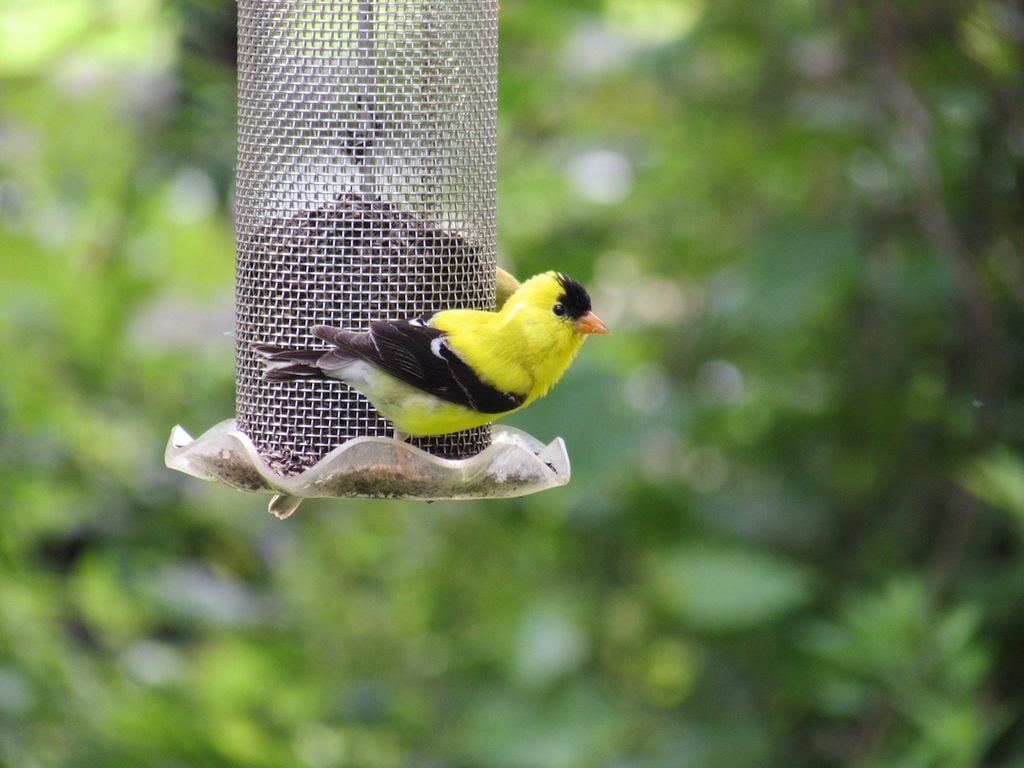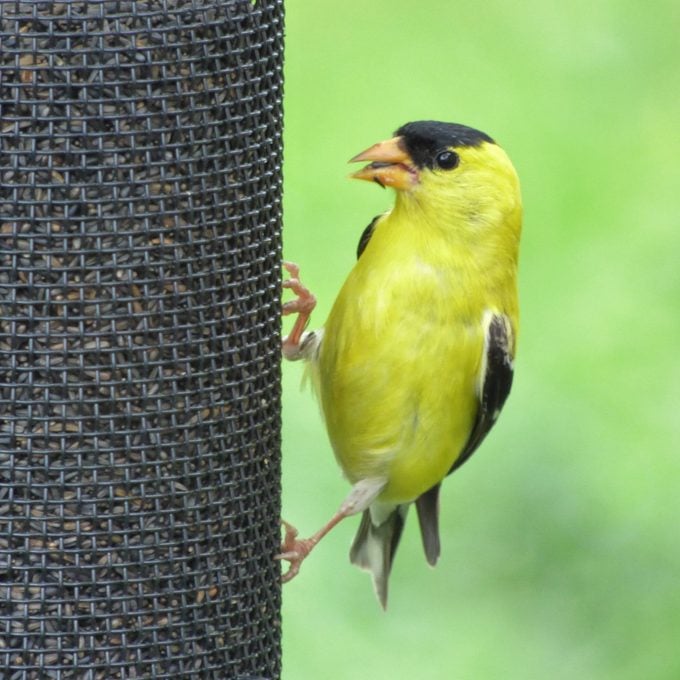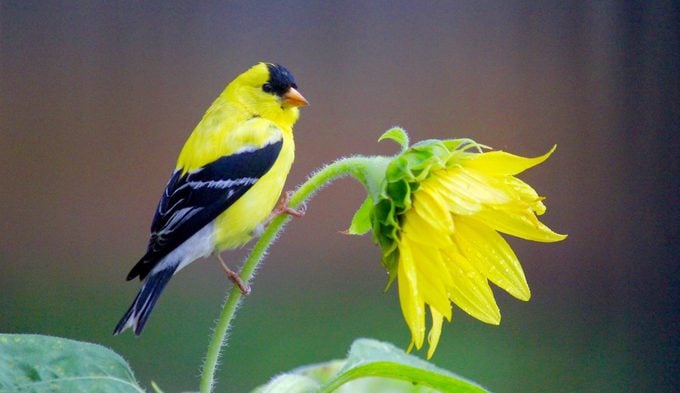How to Attract More Goldfinches to Your Backyard
Updated: Sep. 26, 2023

Get tips on how to attract goldfinches to your backyard. Learn what seeds goldfinches eat from feeders and flowers, and shrubs to plant for their nests.
Our editors and experts handpick every product we feature. We may earn a commission from your purchases.
It’s hard to miss the cheerful yellow and contrasting black and white wing markings of male American goldfinches, especially when they’re crowded around your backyard bird feeder. However, yards with more lawn grass than native flowers and shrubs are not a natural fit for goldfinches. These birds prefer open, weedy fields with shrubby edges. Learn how to attract goldfinches with plants and bird feeders that will make them give your yard a chance.
How to Attract Goldfinches to Bird Feeders
Goldfinches are are big fans of bird feeders. Although goldfinches will eat most small seeds, they love thistle (Nyjer) and sunflower seeds. Keep goldfinches coming back by replacing uneaten food every three to four weeks. Make sure the seed stays dry. Most tube and mesh feeders are fine; a sock feeder also works well. Check out the best finch feeders to serve thistle seed.

What Do Goldfinches Eat?
The goldfinch diet consists almost entirely of seeds, but these birds also occasionally enjoy the bark of young twigs, fresh tree buds and maple sap. Western red cedar, elm, birch and alder trees will encourage more goldfinches to stop by for lunch. In summer, goldfinches add a few small insects to their diets, but seeds remain at the top of the menu.
Meet the 3 types of goldfinches in the United States.
Do Goldfinches Migrate?
If food is plentiful, American goldfinches won’t typically migrate very far, which means their distinctive per-chick-o-ree call can be heard year-round. But you might not notice them at your feeders. When winter arrives, the males take on a more subtle brown coloring to match the females.

Flowers to Attract Goldfinches
If you’re gardening with goldfinches in mind, seed-producing plants are essential. A few favorites include asters, coneflowers, sunflowers and, of course, thistles. They also gravitate toward grasses and weedy plants. Some bird-watchers also swear that yellow flowers attract goldfinches. And while the ornithological jury is out on that assertion, adding goldenrod, yellow zinnias or blanket flowers to the mix can’t hurt, right?
To identify a few other plant options, I talked with people who spend a lot of time watching birds—wildlife photographers. In her upstate New York yard, photographer Marie Read tends a native plant garden that’s just for the birds. There she plants towering cutleaf coneflowers (Rudbeckia laciniata) for goldfinches, and also sees the birds on her Joe Pye weed and cup plant (Silphium perfoliatum).
As a wildlife photographer, Marie has an appreciation for birds that put on a bit of a show, and the American goldfinch fits that description. “They’re very acrobatic,” Marie says. “They won’t just perch on a flower. Goldfinches cling. They will feed upside down.”
And of course, there’s that thistle. “Thistle is their No. 1 choice—that’s guaranteed,” says another photographer, Dave Maslowski. He and brother Steve have spent five decades shooting wildlife photos, mostly of birds.
Pine Siskin vs goldfinch: Here’s how to tell the difference.
Plants Goldfinches Use to Build Nests
Not only will thistle seeds attract goldfinches, the birds famously use down from mature plants to line their nests. It’s one reason the American goldfinch nests so late in the season, usually between late June and early August. The problem with thistle is that many types are invasive. When planting, look for native plants like field thistle (Cirsium discolor), Flogman’s thistle (C. flodmanii) and wavyleaf thistle (C. undulatum), while also checking to assure the variety isn’t a nuisance in your area. The U.S. Department of Agriculture’s invasive and noxious plant listing at plants.usda.gov is a good resource.
Thistle isn’t the only material female goldfinches use to line their nests. Milkweed, cattails and dandelion are other options, as are willow catkins and cottonwood fluff. But the birds will use whatever is available, says Robyn Bailey, project director of the Cornell Lab of Ornithology’s NestWatch. It’s part of what makes the birds so fascinating: They are incredibly adaptable to their environment. One plant to eliminate from a goldfinch habitat is burdock. While feeding on the seeds, goldfinches can become entangled in the burrs of this plant and die.
Check out 9 proven tips to attract nesting birds.
Add Shrubs to Attract Goldfinches to Nest in Your Yard
Given the goldfinch’s habitat, it should come as no surprise that shrubby is a fair description of their nesting sites. Although goldfinches will nest in taller trees, more typical placement is in a shaded location on a low, dense shrub or tree 3 to 10 feet from the ground, Robyn says. And the birds aren’t specialists. “They’ll use whatever is dominant in their habitats,” Robyn says. “In more swampy areas with tamarack, they’ll use tamarack. In an old field with hawthorn, they’ll use hawthorn.”
More important are the characteristics of the shrubs and trees. “Their nest is very much a cup shape, so if they can get access to a more supported structure they’ll use that,” Robyn says. Goldfinches often build nests in a vertical fork, where three or more branches meet to form the perfect spot for that cup shape. Plants like dogwood, elderberry, buttonbush and hawthorn are common, as are Monterey pine, willow and fruit trees. They’ll even nest in thistle plants that have the right structure, Robyn adds.
For cover before or after nesting season, goldfinches seek out many of those same types of plants, as well as low, dense evergreens, especially in winter.
Learn how to create the ultimate backyard wildlife habitat.
